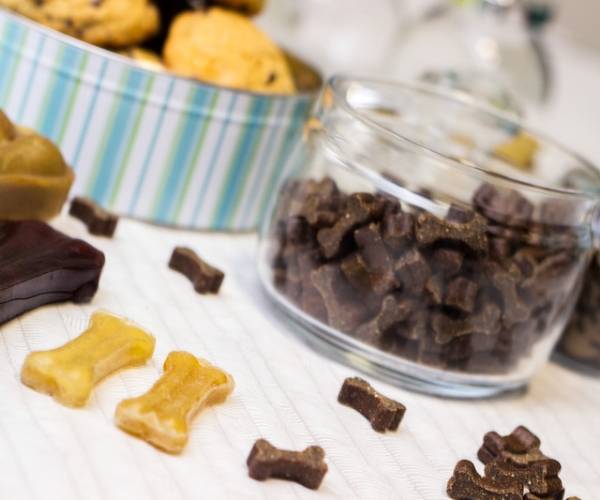Does your dog lose interest in training quickly? Are you tired of constantly buying different types of treats, hoping to find the one that motivates them the most? Are you wondering how do you figure out what treats your dog likes best to get the most out of your training sessions?
If you’ve answered yes to any of these questions then you are feeling like many other dog parents out there.
Treats are the most common reward for training a dog and with so many options choosing a treat that motivates your dog can be challenging and overwhelming.
So, how do you figure out which treats are the most effective to train your dog?
To figure out which treats your dog likes best for training success, follow this simple 3-step process… 1. Gather a variety of treats. 2. test, observe, and analyze your findings. 3. Incorporate the right treats into your dog’s training sessions.
Today I am going to breakdown the 3-step process to help you discover your dog’s favorite training treats… plus I am going to share with you a simple game that you can ‘play’ with your dog to determine which treats they see as high value and low value to use to your advantage during training.
By following these 3 easy steps, you’ll be able to incorporate the right treats into your training sessions, making them more successful and enjoyable for your dog.
So, let’s get started…
High-Value Vs Low-Value Treats.
To understand which treats work better for the type of training your are doing, it is important to understand the difference between a high-value and low-value treat.
What is High-Value and Low-Value Treats?
High value treats are more desirable and enticing to dogs, such as meat, cheese, or freeze-dried liver.
Low value treats are usually lower in calorie and less exciting, like pieces of your dog’s dry dog food or small training treats.
What’s the Difference Between High-Value and Low-Value Treats?
High value treats are very useful for training more complex behaviors, when distractions are present or for when your dog is overly excited, as they can help your dog focus and motivate them to perform the behavior you want.
These treats are also effective for building confidence and trust between you, the trainer, and your fur baby.
Low value treats are best for teaching your dog simple behaviors in a low distraction setting or for reinforcing commands that your dog already knows. These treats are less enticing and help to maintain the dog’s focus without over-stimulating them.
High value treats should be used sparingly to maintain their value, while low value treats can be used more frequently.
The choice of which value training treat to use ultimately depends on what and where you are training your dog.
Now that you know the difference and when to use each type of treat, it’s time to figure out which treats your dog sees as high-value or low-value so you can get the most out of your training sessions and so you can set your dog up for success.
Step 1: Gather a Variety of Treats.

To begin determining your dog’s favorite treats, you’ll want to gather a variety of treat options. It’s important to have a range of textures, flavors, and sizes to see what your dog responds to and likes the best.
Don’t be afraid to mix it up with different types of treats, including soft and chewy, crunchy, and even homemade options such as shredded chicken.
Just remember when choosing treats for training, you want to choose treats that are small and easy to chew quickly. So don’t choose big, crunchy treats. Make sure they are bite-sized or even smaller than bite-sized.
RELATED: 4 Expert Tips on How to Choose the Best Dog Training Treats!
Some ideas of treats you can gather are your dog’s dry dog food, store bought training treats i.e. liver or peanut butter flavor, pieces of cooked meat, tiny pieces of cheese, or small pea-sized pieces of carrots or sweet potatoes.
This will allow you to see what truly motivates your dog.
Step 2: Test, Observe and Analyze Your Dog’s Behavior.
Once you have a variety of treats, it’s time to start the testing and observing phase.
Test and Observe.
This is where you’ll get to see which treats your dog really goes crazy for, which ones motivate them less or which they may snarl their nose up to.
When testing, take note of which treats your dog seems to enjoy the most. Keep track of their behavior and reactions to different treats.
This will help you determine which treats are worth investing in for future training sessions and which treats they value as high value or low value.
Remember a high value treat your dog will go crazy for even in a high distraction setting. A low value treat will get and keep their attention when there are little to no distractions but they could care less about them when they are highly distracted.

Game time!
When doing anything with your dog, especially when training, it’s always best to turn it into a game.
Start by offering one treat at a time to your dog, observe and take note of their reaction:
- How fast is your dog eating it? Do they devour it quickly or do they take their time?
- Are they hesitant to take it or do they eagerly snatch it from your hand?
- Is their tail wagging like crazy or barely even moving?
- Do they sniff it and then turn away?
- Are they barking excitingly?
- Is your dog drooling?
Put the treats your dog goes crazy over in one pile and the less but still appealing treats in another pile.
Once you finish going through and sorting all your treats, lay the high-value treats out beside each other and then allow your dog to go to them and sniff them out.
See which treats he eats first to last. Do the same for the low-value treat pile.
This will tell you which high value treats your dog loves the most and which low value treats they like the most.
It’s also important to test different treats in different situations- in a low distraction area and high distraction area. Try offering treats while your dog is sitting, standing, or lying down. See if they respond differently when they’re already feeling energetic or distracted versus when they’re feeling more relaxed and less distracted.
Once you’ve completed the testing and observing, it’s time to analyze your findings.
Analyze.
Use the information you’ve gathered to determine which treats are your dog’s absolute favorites, which ones they’re less interested in, and which ones they don’t like altogether.
This will allow you to choose the right treats based on your training session so that you can get and keep your dog’s attention and make it a success!
Use their absolute favorites as high value reward training treats. Use the one’s they like but don’t go crazy over as low value training treats and ditch the one’s that they have absolutely no interest in at all.
Step 3: Incorporate the Right Treats into Your Training Sessions.
Once you have identified which treats your dog sees as high value and low value, it’s time to incorporate them into your training sessions.
This will not only help keep your dog’s attention and motivate them to learn, but it will also make the training process much more effective and successful.
Start by using the right treat based upon your training session (what and where you are training your dog).
If you are training your dog in a low distraction setting or reinforcing commands your dog already knows then use the treats that your dog considers as low-value. If you are training a new, more complicated command or are training your dog in a high distraction setting, then use the treats your dog absolutely loves and can’t get enough of (high-value treats).
By incorporating your dog’s favorite treats into training, you’re setting them up for success. Not only will they be more engaged and excited to learn, but they’ll also be more likely to retain the information and behaviors you’re teaching them.

Conclusion.
Choosing the right treats to train your dog doesn’t have to be a frustrating or costly experience…
It’s important to know the difference between a high and low value dog treat so that you can determine which treats are better to use based on the training you are doing.
Then to figure out which treats your dog likes and will respond to the best, you will need to gather a variety of treats, test, observe, and analyze your findings, and then incorporate the right treats into your training sessions.
So what are you waiting for, go grab some dog treats and see which treats your dog likes best what they deem as high-value and low-value so that you can make the most out of your training sessions.
With a little patience and some delicious treats, you’ll have a well-trained dog in no time.
If you have any questions drop them below.
And come back and let me know in the comments which treats your fur baby loves the most. I can’t wait to hear about it! Also, feel free to give this post a share if it helped you.
Frequently Asked Questions
Do dogs get bored of treats?
Dogs can get bored of the same treats if they are constantly given the exact same type or flavor. Just like us humans, dogs appreciate variety.
It is beneficial to switch up the treats occasionally to keep their interest and motivation, especially during high training sessions.
Introducing new flavors or textures can help prevent treat boredom.
Do dogs have favorite treats?
Yes. Dogs, like humans, can have preferences when it comes to treats. Each dog may have their own individual tastes and preferences.
Some dogs may go crazy for meat-based treats like beef, liver, or chicken, while others may prefer the taste of cheese or peanut butter.
It's important to observe your dog's reactions and behaviors during treat testing to determine their favorite treats.
What flavor do dogs love most?
While there isn't a specific flavor that all dogs universally love, many dogs are particularly fond of meat flavors. Common favorites include beef, chicken, turkey, and liver.
It's important to remember that every dog is unique, and their taste preferences may vary. Some dogs may have a preference for sweet flavors, while others may prefer savory or even mild flavors.
Experimenting with different flavors will help you discover what your dog loves the most.
Can I use regular dog food as training treats?
Yes, regular dog food can be used as training treats, especially if your dog enjoys it.
With that said, your dog's food works best as a low-value treat and will work best for low distraction training sessions or for reinforcing commands or behaviors that they already know.
How often should I use high-value treats versus low-value treats during training sessions?
The frequency of using high-value versus low-value treats depends on the complexity of the behavior you're training and the level of distractions.
High-value treats are more effective for challenging or distracting situations, while low-value treats work well for reinforcing known commands or in low-distraction environments.
Generally, high-value treats should be used sparingly to maintain their value, while low-value treats can be used more frequently.

